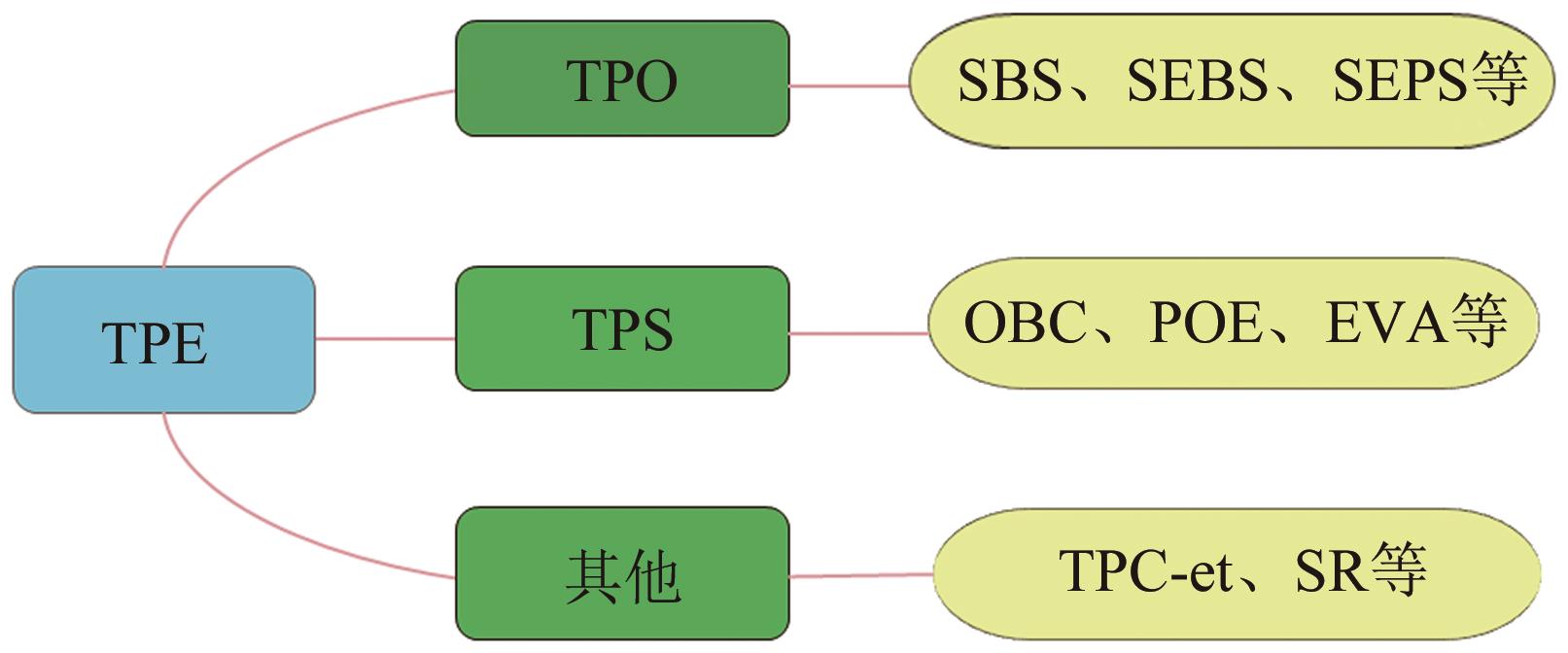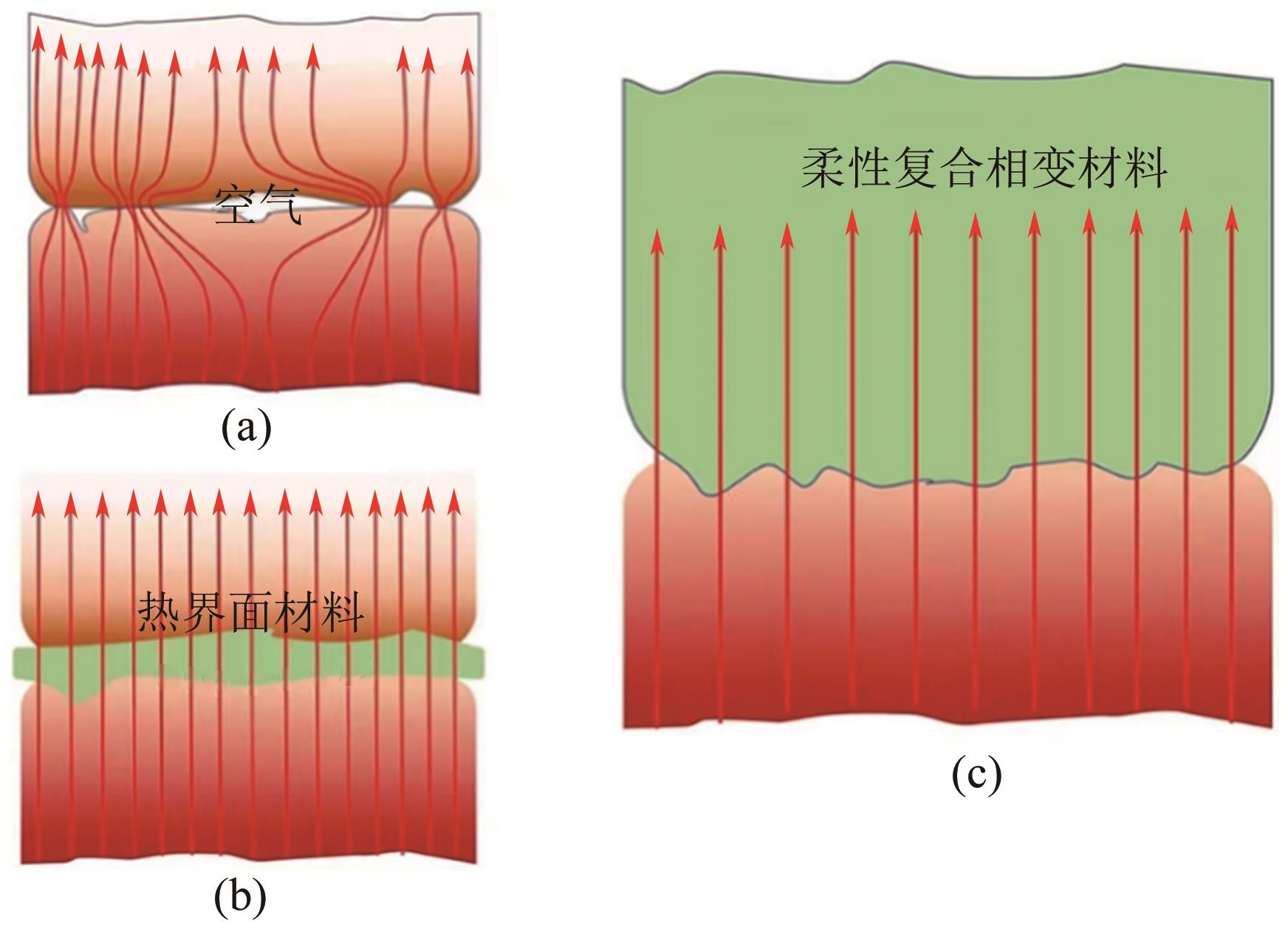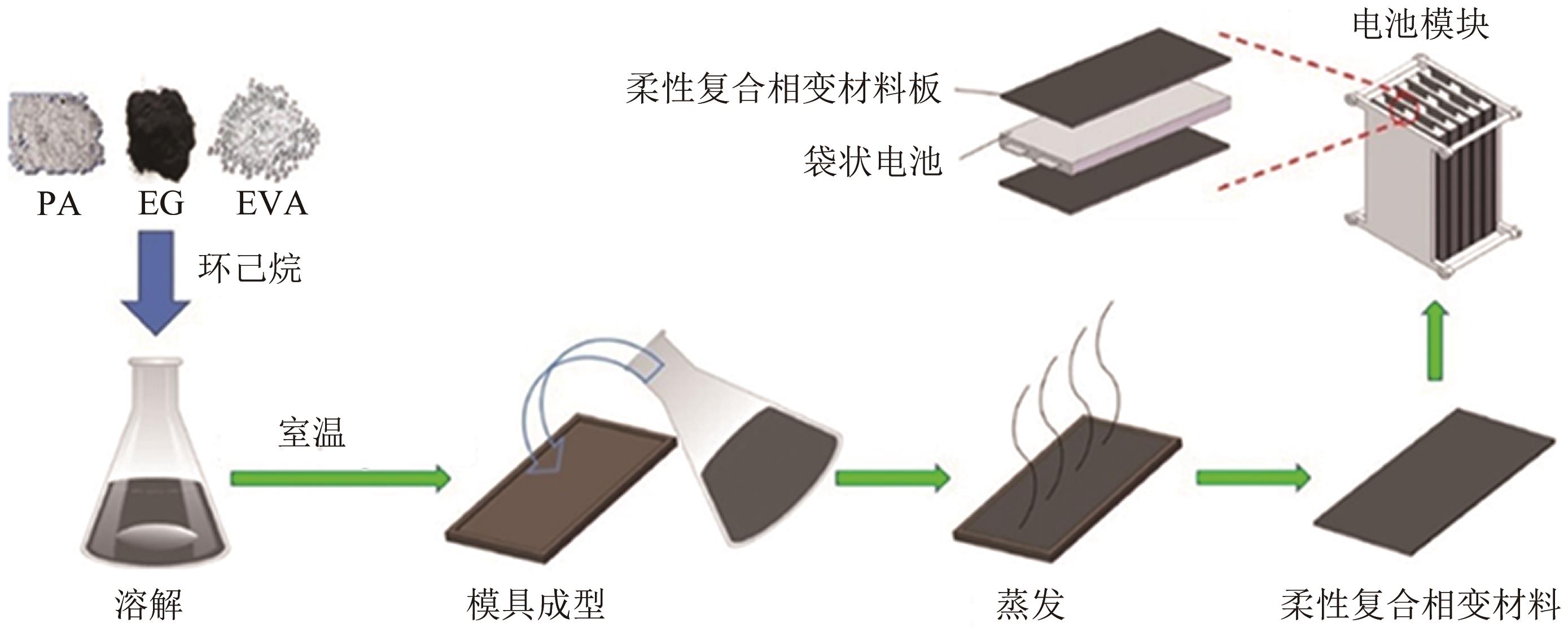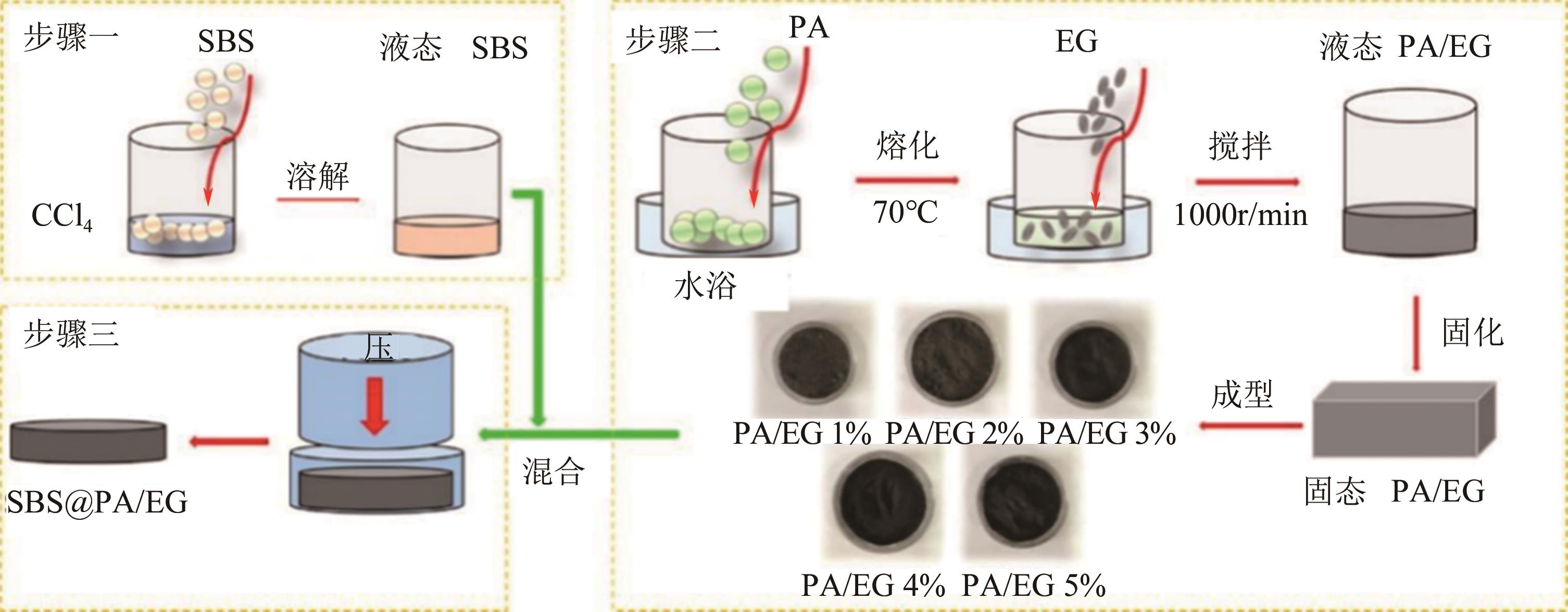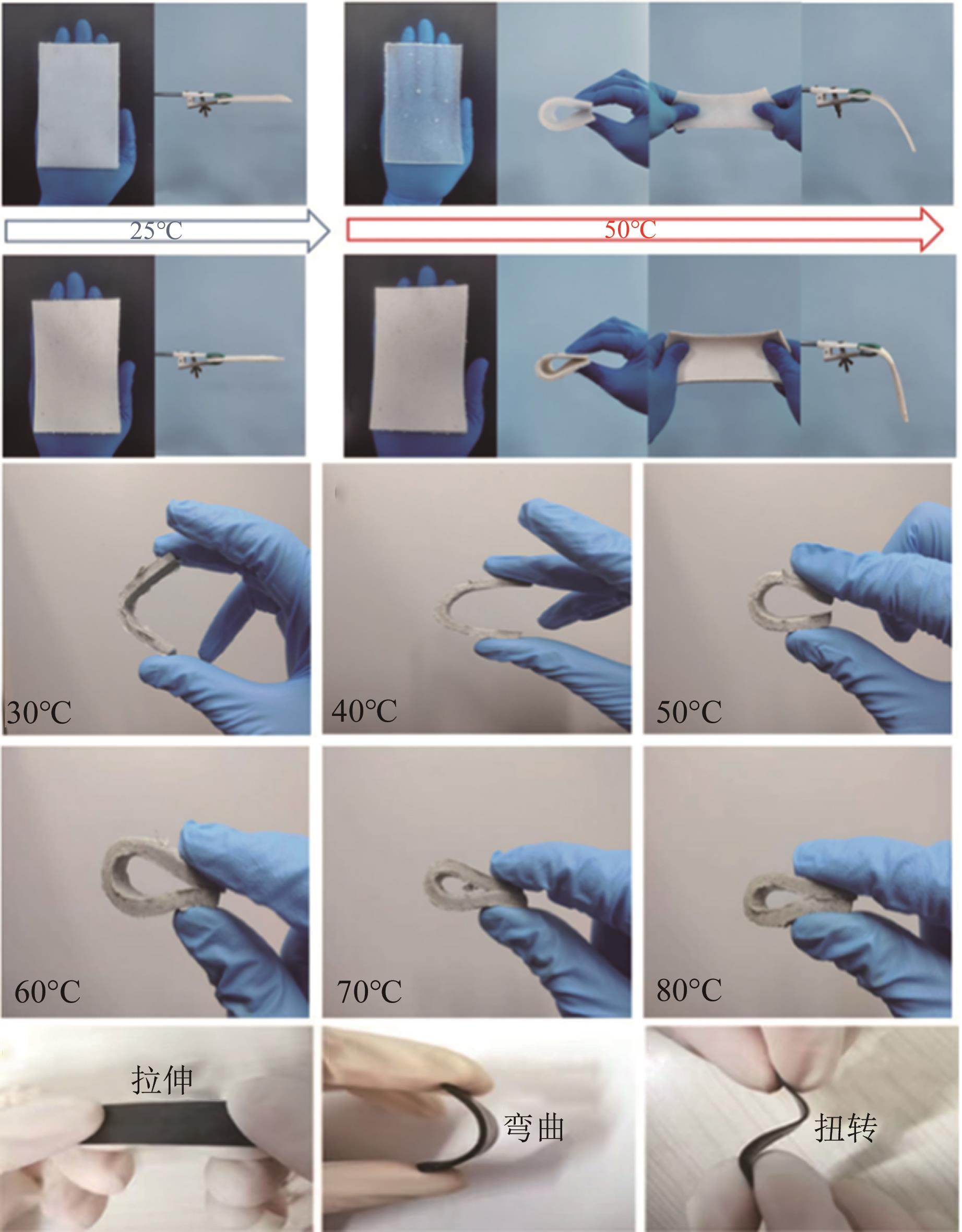化工进展 ›› 2024, Vol. 43 ›› Issue (6): 3159-3173.DOI: 10.16085/j.issn.1000-6613.2023-0855
• 材料科学与技术 • 上一篇
锂电池热管理用TPE基柔性复合相变材料的研究进展
- 1.江西理工大学土木与测绘工程学院,江西 赣州 341000
2.江西理工大学材料冶金化学学部,江西 赣州 341000
-
收稿日期:2023-05-24修回日期:2023-07-02出版日期:2024-06-15发布日期:2024-07-02 -
通讯作者:方敏 -
作者简介:何瑞强(1997—),男,硕士研究生,研究方向为定型复合相变储能材料。E-mail:herq0809@163.com。 -
基金资助:国家自然科学基金面上项目(51966004);江西省自然科学基金(20192BAB216030);江西省教育厅青年项目(GJJ180498)
Research progress of TPE-based flexible composite phase change materials for thermal management of lithium batteries
HE Ruiqiang1( ), FANG Min1(
), FANG Min1( ), ZHOU Jianduo1, FEI Hua1, YANG Kai2
), ZHOU Jianduo1, FEI Hua1, YANG Kai2
- 1.School of Civil Engineering and Surveying and Mapping Engineering, Jiangxi University of Science and Technology, Ganzhou 341000, Jiangxi, China
2.School of Chemistry and Chemical Engineering, Jiangxi University of Science and Technology, Ganzhou 341000, Jiangxi, China
-
Received:2023-05-24Revised:2023-07-02Online:2024-06-15Published:2024-07-02 -
Contact:FANG Min
摘要:
热塑性弹性体(TPE)因其出色的柔韧性、低成本和强相容性,可作为相变材料(PCM)的载体,将其与相变材料和导热填料复合制备的柔性复合相变材料(FCPCM)在电池热管理(BTM)领域具有广泛的应用前景。本文通过总结国内外关于TPE基柔性复合相变材料在电池热管理领域的研究成果,对常用的TPE材料进行了分类并对其工作原理和制备方法等进行了详细介绍。针对相变材料在电池热管理应用中存在的低导热性、低形状稳定性、不良力学性能等问题,本文重点介绍了TPE基柔性复合相变材料的热物理性能(相变潜热和热导率)、电池热管理效果(最高温度和最大温差)、力学性能和抗振性能等。指出当前电池热管理中柔性复合相变材料存在的局限性并对未来的发展方向进行了展望,寻找潜在的柔性材料、协同的二元柔性载体和二元导热填料,提高柔性复合相变材料的绝缘性、介电性和低温适应性等方面应是未来的主要研究方向,增强柔性复合相变材料在振动条件下对锂电池的温控性也需要进一步探索。该综述对电池热管理中TPE基柔性复合相变材料的进一步研究和开发提供重要参考价值。
中图分类号:
引用本文
何瑞强, 方敏, 周健夺, 费华, 杨凯. 锂电池热管理用TPE基柔性复合相变材料的研究进展[J]. 化工进展, 2024, 43(6): 3159-3173.
HE Ruiqiang, FANG Min, ZHOU Jianduo, FEI Hua, YANG Kai. Research progress of TPE-based flexible composite phase change materials for thermal management of lithium batteries[J]. Chemical Industry and Engineering Progress, 2024, 43(6): 3159-3173.
| 材料类型 | 种类 | 价格/CNY·kg-1 | 途径 |
|---|---|---|---|
| TPE | SEBS(美国科腾G1654) | 14.8 | 东莞市晟华塑胶原料有限公司 |
| SEPS(YH-4051) | 23 | 岳阳市巴陵佳云石化有限公司 | |
| SBS | 11 | 惠州市惠州LCY弹性体有限公司 | |
| EVA(美国杜邦EVA 660) | 20 | 东莞市英翔塑胶原料有限公司 | |
| POE(A4090S) | 13.8 | 东莞市缘信塑胶原料有限公司 | |
| OBC(陶氏9530) | 18.8 | 深圳市万塑源橡塑有限公司 | |
| SR(HY系列) | 58 | 深圳红叶硅胶股份科技有限公司 | |
| TPC-et(Hytrel 30HS) | 35 | 东莞市塑佳高分子原料有限公司 | |
| TPE(陶氏杜邦4000-60A) | 20 | 苏州腾旺国际贸易有限公司 | |
| PCM | 切片石蜡(690189610) | 70 | 国药集团化学试剂有限公司 |
| 石蜡 | 45 | 上海焦耳蜡业有限公司 |
表1 部分TPE和PCM的成本比较
| 材料类型 | 种类 | 价格/CNY·kg-1 | 途径 |
|---|---|---|---|
| TPE | SEBS(美国科腾G1654) | 14.8 | 东莞市晟华塑胶原料有限公司 |
| SEPS(YH-4051) | 23 | 岳阳市巴陵佳云石化有限公司 | |
| SBS | 11 | 惠州市惠州LCY弹性体有限公司 | |
| EVA(美国杜邦EVA 660) | 20 | 东莞市英翔塑胶原料有限公司 | |
| POE(A4090S) | 13.8 | 东莞市缘信塑胶原料有限公司 | |
| OBC(陶氏9530) | 18.8 | 深圳市万塑源橡塑有限公司 | |
| SR(HY系列) | 58 | 深圳红叶硅胶股份科技有限公司 | |
| TPC-et(Hytrel 30HS) | 35 | 东莞市塑佳高分子原料有限公司 | |
| TPE(陶氏杜邦4000-60A) | 20 | 苏州腾旺国际贸易有限公司 | |
| PCM | 切片石蜡(690189610) | 70 | 国药集团化学试剂有限公司 |
| 石蜡 | 45 | 上海焦耳蜡业有限公司 |
| 柔性载体 | CPCM | 质量分数比/% | 熔点/℃ | 潜热/kJ·kg-1 | 热导率/W·m-1·K-1 | 参考文献 |
|---|---|---|---|---|---|---|
| SEBS | PA/h-BN/SEBS | 60/20/20 | 41.1 | 127.8 | 2.7 | [ |
| SEBS | PA/EG/SEBS | 76.2/4.8/19 | 47.35 | 159.2 | 1.226 | [ |
| SEPS | PA/EG/SEPS | (85.5/81/72/63)/ (5/10/20/30)/ (9.5/9/8/7) | 48/49.1/50.2/53.1 | 211.9~155.4 | 2.671/4.495/7.475/10.019 | [ |
| SEPS | PA/EG/SEPS | 81/4/15 | 42.5 | 202.78 | 1.581 | [ |
| SBS | PA/CNT/SBS | 85/2/13 | 61.56 | 147.63 | 0.39 | [ |
| PA/SBS | 85/15 | 64.14 | 140.74 | 0.3 | ||
| PA | 61.55 | 200.01 | 0.28 | |||
| SBS | PA/AlN/SBS | 35/15/50 | 46.82 | 57.06 | 0.5 | [ |
| SBS | PA/EG/SBS | 46/5/50 | 47.7 | 79.8 | 0.87 | [ |
| TPS(SBS/SEBS) | PA/EG/TPS | 50/7/43 | 44 | 1.271 | [ |
表2 TPS类部分柔性复合相变材料的热物性参数
| 柔性载体 | CPCM | 质量分数比/% | 熔点/℃ | 潜热/kJ·kg-1 | 热导率/W·m-1·K-1 | 参考文献 |
|---|---|---|---|---|---|---|
| SEBS | PA/h-BN/SEBS | 60/20/20 | 41.1 | 127.8 | 2.7 | [ |
| SEBS | PA/EG/SEBS | 76.2/4.8/19 | 47.35 | 159.2 | 1.226 | [ |
| SEPS | PA/EG/SEPS | (85.5/81/72/63)/ (5/10/20/30)/ (9.5/9/8/7) | 48/49.1/50.2/53.1 | 211.9~155.4 | 2.671/4.495/7.475/10.019 | [ |
| SEPS | PA/EG/SEPS | 81/4/15 | 42.5 | 202.78 | 1.581 | [ |
| SBS | PA/CNT/SBS | 85/2/13 | 61.56 | 147.63 | 0.39 | [ |
| PA/SBS | 85/15 | 64.14 | 140.74 | 0.3 | ||
| PA | 61.55 | 200.01 | 0.28 | |||
| SBS | PA/AlN/SBS | 35/15/50 | 46.82 | 57.06 | 0.5 | [ |
| SBS | PA/EG/SBS | 46/5/50 | 47.7 | 79.8 | 0.87 | [ |
| TPS(SBS/SEBS) | PA/EG/TPS | 50/7/43 | 44 | 1.271 | [ |
| 柔性载体 | CPCM | 质量分数比/% | 熔点/℃ | 潜热/kJ·kg-1 | 热导率/W·m-1·K-1 | 参考文献 |
|---|---|---|---|---|---|---|
| EVA | PA/EG/EVA | (50/49.5/48.5/47.5)/ (0/1/3/5)/ (50/49.5/48.5/47.5) | 53 | 141/129/123/121 | 0.3/0.4/0.9/1.7 | [ |
| EVA | PA/EG/EVA-g-MAH/MA/TPP | 60/3.5/11.5/10/15 | 47.5 | 125.7 | 1.39 | [ |
| POE | PA/EG/POE | (27/36/45/54/63)/ (3/4/5/6/7)/ (70/60/50/40/30) | 65.4/63/64.2/65.3 /65.6 | 51.5/67.1/90.5/108.5/126.7 | 0.62/0.78/0.96/1.41/1.43 | [ |
| OBC | PA/EG/OBC | 45/10/45 | 约51 | 101 | 1.57 | [ |
| OBC | PA/OBC/EG/AlN | 57/20/3/20 | 44.1 | 145.26 | 1.564 | [ |
| OBC | PA/EG/OBC | (79.2/76/72)/ (1/5/10)/ (19.8/19/18) | 50.73/49.67/47.42 | 197.7/185.4 /176.7 | 0.62/2.34/5.5 | [ |
| OBC | PA/EG/OBC | 72/10/18 | 42.3 | 130 | 3 | [ |
表3 TPO类部分柔性复合相变材料的热物性参数
| 柔性载体 | CPCM | 质量分数比/% | 熔点/℃ | 潜热/kJ·kg-1 | 热导率/W·m-1·K-1 | 参考文献 |
|---|---|---|---|---|---|---|
| EVA | PA/EG/EVA | (50/49.5/48.5/47.5)/ (0/1/3/5)/ (50/49.5/48.5/47.5) | 53 | 141/129/123/121 | 0.3/0.4/0.9/1.7 | [ |
| EVA | PA/EG/EVA-g-MAH/MA/TPP | 60/3.5/11.5/10/15 | 47.5 | 125.7 | 1.39 | [ |
| POE | PA/EG/POE | (27/36/45/54/63)/ (3/4/5/6/7)/ (70/60/50/40/30) | 65.4/63/64.2/65.3 /65.6 | 51.5/67.1/90.5/108.5/126.7 | 0.62/0.78/0.96/1.41/1.43 | [ |
| OBC | PA/EG/OBC | 45/10/45 | 约51 | 101 | 1.57 | [ |
| OBC | PA/OBC/EG/AlN | 57/20/3/20 | 44.1 | 145.26 | 1.564 | [ |
| OBC | PA/EG/OBC | (79.2/76/72)/ (1/5/10)/ (19.8/19/18) | 50.73/49.67/47.42 | 197.7/185.4 /176.7 | 0.62/2.34/5.5 | [ |
| OBC | PA/EG/OBC | 72/10/18 | 42.3 | 130 | 3 | [ |
| 柔性载体 | CPCM | 质量分数比/% | 熔点/℃ | 潜热/kJ·kg-1 | 热导率/W·m-1·K-1 | 参考文献 |
|---|---|---|---|---|---|---|
| SR | PA/BN/EG/SR | 30/5.6/3.4/61 | 47.3 | 62.7 | 0.95 | [ |
| TPC-et | PA/EG/TPC-et | 45/10/45 | 102 | 1.64 | [ | |
| TPE | PA/EG/TPE | (27/36/45/54/63)/(3/4/5/6/7)/ (70/60/50/40/30) | 50.4/53/53.8/57.8/59 | 62.3/83.1/103.5/124.6/145.4 | 0.6/0.9/1.4/1.8/2.2 | [ |
| TPEE | PA/EG/TPEE | (59.4/58.2/57)/(1/3/5)/(39.6/38.8/38) | 47.4/46.5/46.4 | 111.2/113.2/112.5 | 0.248/0.502/1.267 | [ |
表4 其他类柔性复合相变材料的热物性参数
| 柔性载体 | CPCM | 质量分数比/% | 熔点/℃ | 潜热/kJ·kg-1 | 热导率/W·m-1·K-1 | 参考文献 |
|---|---|---|---|---|---|---|
| SR | PA/BN/EG/SR | 30/5.6/3.4/61 | 47.3 | 62.7 | 0.95 | [ |
| TPC-et | PA/EG/TPC-et | 45/10/45 | 102 | 1.64 | [ | |
| TPE | PA/EG/TPE | (27/36/45/54/63)/(3/4/5/6/7)/ (70/60/50/40/30) | 50.4/53/53.8/57.8/59 | 62.3/83.1/103.5/124.6/145.4 | 0.6/0.9/1.4/1.8/2.2 | [ |
| TPEE | PA/EG/TPEE | (59.4/58.2/57)/(1/3/5)/(39.6/38.8/38) | 47.4/46.5/46.4 | 111.2/113.2/112.5 | 0.248/0.502/1.267 | [ |
| 柔性载体 | CPCM | 质量分数比/% | 环境温度/℃ | 放电倍率 | 最高温度/℃ | 最大温差/℃ | 参考文献 |
|---|---|---|---|---|---|---|---|
| SEBS | PA/h-BN/SEBS | 60/20/20 | 25 | 1C/2C/3C | 35/40/47 | 1.1/1.2/2.1 | [ |
| NC | — | 25 | 1C/2C/3C | 43/58/76.1 | 4.3/5.4/6.7 | ||
| SEBS | PA/EG/SEBS | 76.2/4.8/19 | 30 | 1C/2C/3C | 35.8/39.4/42.2 | 1.6/2.5/3.3 | [ |
| SEPS | PA/EG/SEPS | 85.5/5/9.5 | — | 2C/3C | 38.6/43.2 | 0.7/1.5 | [ |
| PA/EG/SEPS | 72/20/8 | — | 2C/3C | 38.1/42.2 | 0.4/1.0 | ||
| SEPS | PA/EG/SEPS | 82/3/15 | — | 1C/2C/3C | 33.73/38.46/42.96 | 0.2/0.5/0.6 | [ |
| PA/SEPS | 90/10 | — | 1C/2C/3C | 35.13/40.65/47.35 | 0.4/0.78/1.2 | ||
| 无PCM | — | — | 1C/2C/3C | 35.15/41.49/51.01 | 0.79/1.68/3.1 | ||
| SBS | PA/AlN/SBS | 35/15/50 | — | 1C/2C/3C | 32.5/34/42.5 | 0.9/2/8.9 | [ |
| TPS(SBS/SEBS) | PA/EG/TPS | 50/7/43 | 26 | 1C/2C/2.5C | 30.5/33.9/36.2 | 2.9/3.7/4.0 | [ |
| NC | — | 26 | 1C/2C/2.5C | 36.4/42.6/47.9 | 4.9/5.7/7.5 |
表5 TPS类柔性复合相变材料的电池热管理参数
| 柔性载体 | CPCM | 质量分数比/% | 环境温度/℃ | 放电倍率 | 最高温度/℃ | 最大温差/℃ | 参考文献 |
|---|---|---|---|---|---|---|---|
| SEBS | PA/h-BN/SEBS | 60/20/20 | 25 | 1C/2C/3C | 35/40/47 | 1.1/1.2/2.1 | [ |
| NC | — | 25 | 1C/2C/3C | 43/58/76.1 | 4.3/5.4/6.7 | ||
| SEBS | PA/EG/SEBS | 76.2/4.8/19 | 30 | 1C/2C/3C | 35.8/39.4/42.2 | 1.6/2.5/3.3 | [ |
| SEPS | PA/EG/SEPS | 85.5/5/9.5 | — | 2C/3C | 38.6/43.2 | 0.7/1.5 | [ |
| PA/EG/SEPS | 72/20/8 | — | 2C/3C | 38.1/42.2 | 0.4/1.0 | ||
| SEPS | PA/EG/SEPS | 82/3/15 | — | 1C/2C/3C | 33.73/38.46/42.96 | 0.2/0.5/0.6 | [ |
| PA/SEPS | 90/10 | — | 1C/2C/3C | 35.13/40.65/47.35 | 0.4/0.78/1.2 | ||
| 无PCM | — | — | 1C/2C/3C | 35.15/41.49/51.01 | 0.79/1.68/3.1 | ||
| SBS | PA/AlN/SBS | 35/15/50 | — | 1C/2C/3C | 32.5/34/42.5 | 0.9/2/8.9 | [ |
| TPS(SBS/SEBS) | PA/EG/TPS | 50/7/43 | 26 | 1C/2C/2.5C | 30.5/33.9/36.2 | 2.9/3.7/4.0 | [ |
| NC | — | 26 | 1C/2C/2.5C | 36.4/42.6/47.9 | 4.9/5.7/7.5 |
| 柔性载体 | CPCM | 质量分数比/% | 环境温度/℃ | 放电倍率 | 最高温度/℃ | 最大温差/℃ | 参考文献 |
|---|---|---|---|---|---|---|---|
| EVA | PA/EG/EVA | 47.5/5/47.5 | 30 | 1C/2C/3C/4C | 38/44.3/50/50.3 | 2.8/3.9/4.1/4.5 | [ |
| PA/EG/LDPE | 47.5/5/47.5 | 30 | 1C/2C/3C/4C | 40.1/46.3/48/55.8 | 3.5/4.4/4.8/6.1 | ||
| EVA | PA/EG/EVA-g-MAH/MA/TPP | 60/3.5/11.5/10/15 | 25 | 1C/2C/3C | 34.3/42.5/44.3 | 1.7/2.6/3 | [ |
| OBC | PA/EG/OBC | 76/5/19 | — | 1C/2C/2.5C | 34/42/44 | — | [ |
表6 TPO类部分柔性复合相变材料的电池热管理参数
| 柔性载体 | CPCM | 质量分数比/% | 环境温度/℃ | 放电倍率 | 最高温度/℃ | 最大温差/℃ | 参考文献 |
|---|---|---|---|---|---|---|---|
| EVA | PA/EG/EVA | 47.5/5/47.5 | 30 | 1C/2C/3C/4C | 38/44.3/50/50.3 | 2.8/3.9/4.1/4.5 | [ |
| PA/EG/LDPE | 47.5/5/47.5 | 30 | 1C/2C/3C/4C | 40.1/46.3/48/55.8 | 3.5/4.4/4.8/6.1 | ||
| EVA | PA/EG/EVA-g-MAH/MA/TPP | 60/3.5/11.5/10/15 | 25 | 1C/2C/3C | 34.3/42.5/44.3 | 1.7/2.6/3 | [ |
| OBC | PA/EG/OBC | 76/5/19 | — | 1C/2C/2.5C | 34/42/44 | — | [ |
| 柔性载体 | CPCM | 质量分数比/% | 环境温度/℃ | 放电倍率 | 最高温度/℃ | 最大温差/℃ | 参考文献 |
|---|---|---|---|---|---|---|---|
| TPC-et | PA/EG/TPC-et | 45/10/45 | 30 | 1C/2C/3C | 33.5/37.2/41.1 | — | [ |
| NC | — | 30 | 1C/2C/3C | 34.8/41.6/44.6 | — | ||
| TPEE | PA/EG/TPEE | 57/5/38 | 25 | 1C/3C/5C | 32.6/42.3/49.9 | 0.95/1.39/1.95 | [ |
| NC | — | — | 1C/3C/5C | 38.1/63.7/82.2 | — | ||
| SR | PA/BN/EG/SR | 61.1/5.6/3.3/30 | 25 | 3C/4C | 45.7/53.4 | 1.9/3.7 | [ |
| NC | — | 25 | 3C/4C | 60.3/74.3 | 3.3/9.1 |
表7 其他类部分柔性复合相变材料的电池热管理参数
| 柔性载体 | CPCM | 质量分数比/% | 环境温度/℃ | 放电倍率 | 最高温度/℃ | 最大温差/℃ | 参考文献 |
|---|---|---|---|---|---|---|---|
| TPC-et | PA/EG/TPC-et | 45/10/45 | 30 | 1C/2C/3C | 33.5/37.2/41.1 | — | [ |
| NC | — | 30 | 1C/2C/3C | 34.8/41.6/44.6 | — | ||
| TPEE | PA/EG/TPEE | 57/5/38 | 25 | 1C/3C/5C | 32.6/42.3/49.9 | 0.95/1.39/1.95 | [ |
| NC | — | — | 1C/3C/5C | 38.1/63.7/82.2 | — | ||
| SR | PA/BN/EG/SR | 61.1/5.6/3.3/30 | 25 | 3C/4C | 45.7/53.4 | 1.9/3.7 | [ |
| NC | — | 25 | 3C/4C | 60.3/74.3 | 3.3/9.1 |
| 柔性载体 | CPCM | 质量分数比 /% | 抗压强度 /MPa | 抗拉强度 /MPa | 抗弯强度 /MPa | 最大应力 /MPa | 断裂伸长率 /% | 参考文献 |
|---|---|---|---|---|---|---|---|---|
| SEBS | PA/h-BN/SEBS | 60/20/20 | — | 0.72 | — | — | — | [ |
| SBS | PA/CNT/SBS | (80/85/90)/2/(18/13/8) | — | 0.5~0.75 | — | /1.47/1.78 | 13.79/20.33/2.58 | [ |
| SBS | PA/AlN/SBS | 50/15/35 | — | 0.19 | 0.6 | — | — | [ |
| EVA | PA/EG/EVA | 47.5/5/47.5 | 8.07 | 0.83 | 0.02 | — | 3.68 | [ |
| PA/EG/LDPE | 47.5/5/47.5 | 143.45 | 81.2 | 2.45 | — | 1.98 | ||
| OBC | PA/EG/OBC | 45/10/45 | 34.36 | 5.44 | 1.21 | — | 3.62 | [ |
| SR | PA/BN/EG/SR | 61.1/5.6/3.4/30 | 0.7 | — | — | — | — | [ |
| PW/EG/SR | 0.46 | — | — | — | — | |||
| TPC-et | PA/EG/TPC-et | 45/10/45 | 5.02 | 0.88 | 0.14 | — | 5.24 | [ |
| TPS(SBS/SEBS) | PA/EG/TPS | 50/7/43 | — | 0.408 | — | — | 41.257 | [ |
| TPEE | PA/EG/TPEE | (59.4/58.2/57)/(1/3/5)/(39.6/38.8/38) | — | 4.9/4.6/4.5 | — | — | — | [ |
表8 TPE类部分柔性复合相变材料的力学性能参数
| 柔性载体 | CPCM | 质量分数比 /% | 抗压强度 /MPa | 抗拉强度 /MPa | 抗弯强度 /MPa | 最大应力 /MPa | 断裂伸长率 /% | 参考文献 |
|---|---|---|---|---|---|---|---|---|
| SEBS | PA/h-BN/SEBS | 60/20/20 | — | 0.72 | — | — | — | [ |
| SBS | PA/CNT/SBS | (80/85/90)/2/(18/13/8) | — | 0.5~0.75 | — | /1.47/1.78 | 13.79/20.33/2.58 | [ |
| SBS | PA/AlN/SBS | 50/15/35 | — | 0.19 | 0.6 | — | — | [ |
| EVA | PA/EG/EVA | 47.5/5/47.5 | 8.07 | 0.83 | 0.02 | — | 3.68 | [ |
| PA/EG/LDPE | 47.5/5/47.5 | 143.45 | 81.2 | 2.45 | — | 1.98 | ||
| OBC | PA/EG/OBC | 45/10/45 | 34.36 | 5.44 | 1.21 | — | 3.62 | [ |
| SR | PA/BN/EG/SR | 61.1/5.6/3.4/30 | 0.7 | — | — | — | — | [ |
| PW/EG/SR | 0.46 | — | — | — | — | |||
| TPC-et | PA/EG/TPC-et | 45/10/45 | 5.02 | 0.88 | 0.14 | — | 5.24 | [ |
| TPS(SBS/SEBS) | PA/EG/TPS | 50/7/43 | — | 0.408 | — | — | 41.257 | [ |
| TPEE | PA/EG/TPEE | (59.4/58.2/57)/(1/3/5)/(39.6/38.8/38) | — | 4.9/4.6/4.5 | — | — | — | [ |
| 1 | HUA Yang, ZHOU Sida, HUANG Yi, et al. Sustainable value chain of retired lithium-ion batteries for electric vehicles[J]. Journal of Power Sources, 2020, 478: 228753. |
| 2 | CHITTA Sandeep Dattu, AKKALDEVI Chaithanya, JAIDI Jeevan, et al. Comparison of lumped and 1D electrochemical models for prismatic 20Ah LiFePO4 battery sandwiched between minichannel cold-plates[J]. Applied Thermal Engineering, 2021, 199: 117586. |
| 3 | Antti VÄYRYNEN, SALMINEN Justin. Lithium ion battery production[J]. The Journal of Chemical Thermodynamics, 2012, 46: 80-85. |
| 4 | AMJAD Muhammad, AHMAD Ayaz, REHMANI Mubashir Husain, et al. A review of EVs charging: From the perspective of energy optimization, optimization approaches, and charging techniques[J]. Transportation Research Part D: Transport and Environment, 2018, 62: 386-417. |
| 5 | YANG Ruixin, XIONG Rui, SHEN Weixiang, et al. Extreme learning machine-based thermal model for lithium-ion batteries of electric vehicles under external short circuit[J]. Engineering, 2021, 7(3): 395-405. |
| 6 | KSHETRIMAYUM Krishnadash S, YOON Young-Gak, Hye-Ri GYE, et al. Preventing heat propagation and thermal runaway in electric vehicle battery modules using integrated PCM and micro-channel plate cooling system[J]. Applied Thermal Engineering, 2019, 159: 113797. |
| 7 | WU Weixiong, WU Wei, WANG Shuangfeng. Thermal optimization of composite PCM based large-format lithium-ion battery modules under extreme operating conditions[J]. Energy Conversion and Management, 2017, 153: 22-33. |
| 8 | TIARI Saeed, MAHDAVI Mahboobe, QIU Songgang. Experimental study of a latent heat thermal energy storage system assisted by a heat pipe network[J]. Energy Conversion and Management, 2017, 153: 362-373. |
| 9 | NA Xiaoyu, KANG Huifang, WANG Teng, et al. Reverse layered air flow for Li-ion battery thermal management[J]. Applied Thermal Engineering, 2018, 143: 257-262. |
| 10 | TANG Zhiguo, LIU Zhiqing, LI Jie, et al. A lightweight liquid cooling thermal management structure for prismatic batteries[J]. Journal of Energy Storage, 2021, 42: 103078. |
| 11 | CHOUDHARI V G, DHOBLE A S, PANCHAL Satyam, et al. Numerical investigation on thermal behaviour of 5 × 5 cell configured battery pack using phase change material and fin structure layout[J]. Journal of Energy Storage, 2021, 43: 103234. |
| 12 | WENG Jingwen, HE Yaping, OUYANG Dongxu, et al. Thermal performance of PCM and branch-structured fins for cylindrical power battery in a high-temperature environment[J]. Energy Conversion and Management, 2019, 200: 112106. |
| 13 | PING Ping, PENG Rongqi, KONG Depeng, et al. Investigation on thermal management performance of PCM-fin structure for Li-ion battery module in high-temperature environment[J]. Energy Conversion and Management, 2018, 176: 131-146. |
| 14 | LI Yantong, DU Yaxing, XU Tao, et al. Optimization of thermal management system for Li-ion batteries using phase change material[J]. Applied Thermal Engineering, 2018, 131: 766-778. |
| 15 | GRECO Angelo, JIANG Xi, CAO Dongpu. An investigation of lithium-ion battery thermal management using paraffin/porous-graphite-matrix composite[J]. Journal of Power Sources, 2015, 278: 50-68. |
| 16 | HUSSAIN Abid, ABIDI Irfan H, TSO C Y, et al. Thermal management of lithium ion batteries using graphene coated nickel foam saturated with phase change materials[J]. International Journal of Thermal Sciences, 2018, 124: 23-35. |
| 17 | LUO Dajun, XIANG Li, SUN Xin, et al. Phase-change smart lines based on paraffin-expanded graphite/polypropylene hollow fiber membrane composite phase change materials for heat storage[J]. Energy, 2020, 197: 117252. |
| 18 | SAMIMI Fereshteh, BABAPOOR Aziz, AZIZI Mohammadmehdi, et al. Thermal management analysis of a Li-ion battery cell using phase change material loaded with carbon fibers[J]. Energy, 2016, 96: 355-371. |
| 19 | BABAPOOR A, AZIZI M, KARIMI G. Thermal management of a Li-ion battery using carbon fiber-PCM composites[J]. Applied Thermal Engineering, 2015, 82: 281-290. |
| 20 | MISHRA A K, LAHIRI B B, PHILIP J. Carbon black nano particle loaded lauric acid-based form-stable phase change material with enhanced thermal conductivity and photo-thermal conversion for thermal energy storage[J]. Energy, 2020, 191: 116572. |
| 21 | BABAPOOR Aziz, KARIMI Gholamreza, SABBAGHI Samad. Thermal characteristic of nanocomposite phase change materials during solidification process[J]. Journal of Energy Storage, 2016, 7: 74-81. |
| 22 | NOËL John A, WHITE Mary Anne. Freeze-cast form-stable phase change materials for thermal energy storage[J]. Solar Energy Materials and Solar Cells, 2021, 223: 110956. |
| 23 | Youfu LYU, LIU Guangjun, ZHANG Guoqing, et al. A novel thermal management structure using serpentine phase change material coupled with forced air convection for cylindrical battery modules[J]. Journal of Power Sources, 2020, 468: 228398. |
| 24 | MU Mulan, BASHEER P A M, SHA Wei, et al. Shape stabilised phase change materials based on a high melt viscosity HDPE and paraffin waxes[J]. Applied Energy, 2016, 162: 68-82. |
| 25 | MAO Dasha, CHEN Jiahui, REN Linlin, et al. Spherical core-shell Al@Al2O3 filled epoxy resin composites as high-performance thermal interface materials[J]. Composites A: Applied Science and Manufacturing, 2019, 123: 260-269. |
| 26 | KRUPA I, MIKOVÁ G, LUYT A S. Polypropylene as a potential matrix for the creation of shape stabilized phase change materials[J]. European Polymer Journal, 2007, 43(3): 895-907. |
| 27 | HUANG Qiqiu, LI Xinxi, ZHANG Guoqing, et al. Experimental investigation of the thermal performance of heat pipe assisted phase change material for battery thermal management system[J]. Applied Thermal Engineering, 2018, 141: 1092-1100. |
| 28 | JIANG Z Y, QU Z G. Lithium-ion battery thermal management using heat pipe and phase change material during discharge-charge cycle: A comprehensive numerical study[J]. Applied Energy, 2019, 242: 378-392. |
| 29 | WU Tingting, HU Yanxin, RONG Huiqiang, et al. SEBS-based composite phase change material with thermal shape memory for thermal management applications[J]. Energy, 2021, 221: 119900. |
| 30 | WU Weixiong, LIU Jizhen, LIU Min, et al. An innovative battery thermal management with thermally induced flexible phase change material[J]. Energy Conversion and Management, 2020, 221: 113145. |
| 31 | BRAND Martin J, SCHUSTER Simon F, BACH Tobias, et al. Effects of vibrations and shocks on lithium-ion cells[J]. Journal of Power Sources, 2015, 288: 62-69. |
| 32 | LILLEY Drew, LAU Jonathan, DAMES Chris, et al. Impact of size and thermal gradient on supercooling of phase change materials for thermal energy storage[J]. Applied Energy, 2021, 290: 116635. |
| 33 | JOSHY Naveen, HAJIYAN Mohammadhossein, SIDDIQUE Abu Raihan Mohammad, et al. Experimental investigation of the effect of vibration on phase change material (PCM) based battery thermal management system[J]. Journal of Power Sources, 2020, 450: 227717. |
| 34 | 崔小明. 我国丁苯热塑性弹性体的市场现状及发展前景[J]. 化学工业, 2011, 29(1): 15-17, 24. |
| CUI Xiaoming. Supply, demand status and development prospect of SBS in China[J]. Chemical Industry, 2011, 29(1): 15-17, 24. | |
| 35 | 贺小进, 王雪, 邱迎昕. SEEPS结构、性能及应用研究进展[J]. 石化技术, 2019, 26(11): 1-4. |
| HE Xiaojin, WANG Xue, QIU Yingxin. Advances on structure, properties and applications of SEEPS[J]. Petrochemical Industry Technology, 2019, 26(11): 1-4. | |
| 36 | 郭方飞, 闫邦锋, 崔志勇, 等. SEPS热塑性弹性体的催化专利进展[J]. 工业催化, 2016, 24(11): 6-9. |
| GUO Fangfei, YAN Bangfeng, CUI Zhiyong, et al. Catalytic patent progress in thermoplastic elastomer SEPS[J]. Industrial Catalysis, 2016, 24(11): 6-9. | |
| 37 | ZHANG Zishou, ZHAI Teng, LU Xihong, et al. Conductive membranes of EVA filled with carbon black and carbon nanotubes for flexible energy-storage devices[J]. Journal of Materials Chemistry A, 2013, 1(3): 505-509. |
| 38 | HEMANTH R, SURESHA B, SEKAR M. Effect of short glass fibre and fillers on friction and wear performance of multi-phased thermoplastic copolyester elastomer composites[J]. International Journal of Nanotechnology, 2017, 14(9/10/11): 893. |
| 39 | JI Tuo, ZHANG Liqun, WANG Wencai, et al. Cold plasma modification of boron nitride fillers and its effect on the thermal conductivity of silicone rubber/boron nitride composites[J]. Polymer Composites, 2012, 33(9): 1473-1481. |
| 40 | RAZEEB Kafil M, DALTON Eric, CROSS Graham Lawerence William, et al. Present and future thermal interface materials for electronic devices[J]. International Materials Reviews, 2018, 63(1): 1-21. |
| 41 | YANG Kaixin, LING Ziye, FANG Xiaoming, et al. Introducing a flexible insulation network to the expanded graphite-based composite phase change material to enhance dielectric and mechanical properties for battery thermal management[J]. Journal of Energy Storage, 2023, 66: 107486. |
| 42 | WENG Jingwen, HUANG Qiqiu, LI Xinxi, et al. Safety issue on PCM-based battery thermal management: Material thermal stability and system hazard mitigation[J]. Energy Storage Materials, 2022, 53: 580-612. |
| 43 | YANG Xiaoping, ZHANG Zhihao, CAI Zhuodi, et al. Experimental investigation on room-temperature flexible composite phase change materials in thermal management of power battery pack[J]. Applied Thermal Engineering, 2022, 213: 118748. |
| 44 | HUANG Qiqiu, LI Xinxi, ZHANG Guoqing, et al. Flexible composite phase change material with anti-leakage and anti-vibration properties for battery thermal management[J]. Applied Energy, 2022, 309: 118434. |
| 45 | LI Shaojun, DONG Xinlong, LIN Xiaodong, et al. Flexible phase change materials obtained from a simple solvent-evaporation method for battery thermal management[J]. Journal of Energy Storage, 2021, 44: 103447. |
| 46 | YANG Chong, CAI Zhijing, CHEN Hong, et al. Measurement and correlation of liquid-liquid equilibria for extracting isopropanol from cyclohexane with different solvents[J]. Journal of Chemical & Engineering Data, 2020, 65(1): 140-145. |
| 47 | HUANG Qiqiu, LI Xinxi, ZHANG Guoqing, et al. Thermal management of Lithium-ion battery pack through the application of flexible form-stable composite phase change materials[J]. Applied Thermal Engineering, 2021, 183: 116151. |
| 48 | UMAIR Malik Muhammad, ZHANG Yuang, IQBAL Kashif, et al. Novel strategies and supporting materials applied to shape-stabilize organic phase change materials for thermal energy storage-a review[J]. Applied Energy, 2019, 235: 846-873. |
| 49 | HU Die, HAN Liang, ZHOU Weiqing, et al. Flexible phase change composite based on loading paraffin into cross-linked CNT/SBS network for thermal management and thermal storage[J]. Chemical Engineering Journal, 2022, 437: 135056. |
| 50 | HUANG Qiqiu, DENG Jian, LI Xinxi, et al. Experimental investigation on thermally induced aluminum nitride based flexible composite phase change material for battery thermal management[J]. Journal of Energy Storage, 2020, 32: 101755. |
| 51 | RONG Huiqiang, WANG Changhong, LIU Xianqing, et al. A novel elastomeric copolymer-based phase change material with thermally induced flexible and shape-stable performance for prismatic battery module[J]. International Journal of Thermal Sciences, 2022, 174: 107435. |
| 52 | CAO Jiahao, LING Ziye, LIN Xuemin, et al. Flexible composite phase change material with enhanced thermophysical, dielectric, and mechanical properties for battery thermal management[J]. Journal of Energy Storage, 2022, 52: 104796. |
| 53 | LIN Xiangwei, ZHANG Xuelai, JI Jun, et al. Experimental investigation of form-stable phase change material with enhanced thermal conductivity and thermal-induced flexibility for thermal management[J]. Applied Thermal Engineering, 2022, 201: 117762. |
| 54 | LIN Xiangwei, ZHANG Xuelai, LIU Lu, et al. Polymer/expanded graphite-based flexible phase change material with high thermal conductivity for battery thermal management[J]. Journal of Cleaner Production, 2022, 331: 130014. |
| 55 | YANG Xiaoping, DENG Guolan, CAI Zhuodi, et al. Experimental study on novel composite phase change materials with room-temperature flexibility and high-temperature shape stability in a battery thermal management system[J]. International Journal of Heat and Mass Transfer, 2023, 206: 123953. |
| 56 | LI Yuming, WANG Tingyu, LI Xinxi, et al. Experimental investigation on thermal management system with flame retardant flexible phase change material for retired battery module[J]. Applied Energy, 2022, 327: 120109. |
| 57 | ZOU Xuelin, LIU Jian. Polyoxyethylene based phase change materials with enhanced mechanical property, thermal conductivity and photo-thermal energy charging capacity[J]. Energy Reports, 2020, 6: 2948-2955. |
| 58 | WU Weifeng, YE Guohua, ZHANG Guoqing, et al. Composite phase change material with room-temperature-flexibility for battery thermal management[J]. Chemical Engineering Journal, 2022, 428: 131116. |
| 59 | LIN Xiangwei, ZHANG Xuelai, JI Jun, et al. Development of flexible form-stable phase change material with enhanced electrical resistance for thermal management[J]. Journal of Cleaner Production, 2021, 311: 127517. |
| 60 | WU Weixiong, WU Wei, WANG Shuangfeng. Form-stable and thermally induced flexible composite phase change material for thermal energy storage and thermal management applications[J]. Applied Energy, 2019, 236: 10-21. |
| 61 | CHENG Gong, WANG Zhangzhou, WANG Xinzhi, et al. All-climate thermal management structure for batteries based on expanded graphite/polymer composite phase change material with a high thermal and electrical conductivity[J]. Applied Energy, 2022, 322: 119509. |
| 62 | ZHANG Yafang, HUANG Juhua, CAO Ming, et al. A novel flexible phase change material with well thermal and mechanical properties for lithium batteries application[J]. Journal of Energy Storage, 2021, 44: 103433. |
| 63 | CAI Zhuodi, LIU Jian, ZHOU Yanxue, et al. Flexible phase change materials with enhanced tensile strength, thermal conductivity and photo-thermal performance[J]. Solar Energy Materials and Solar Cells, 2021, 219: 110728. |
| 64 | ZHAO Xiangyu, LEI Ke, WANG Shuo, et al. A shape-memory, room-temperature flexible phase change material based on PA/TPEE/EG for battery thermal management[J]. Chemical Engineering Journal, 2023, 463: 142514. |
| 65 | YE Guohua, ZHANG Guoqing, JIANG Liqin, et al. Temperature control of battery modules through composite phase change materials with dual operating temperature regions[J]. Chemical Engineering Journal, 2022, 449: 137733. |
| 66 | CHAVAN Santosh, VENKATESWARLU B, PRABAKARAN R, et al. Thermal runaway and mitigation strategies for the electric vehicle lithium-ion batteries: A review on current status and challenges[J]. Case Studies in Thermal Engineering, 2023, 49: 103079. |
| 67 | LUO Jie, ZOU Deqiu, WANG Yinshuang, et al. Battery thermal management systems (BTMs) based on phase change material (PCM): A comprehensive review[J]. Chemical Engineering Journal, 2022, 430: 132741. |
| 68 | YU X K, TAO Y B. Improvement of thermal cycle stability of paraffin/expanded graphite composite phase change materials and its application in thermal management[J]. Journal of Energy Storage, 2023, 63: 107019. |
| 69 | HE Jieshan, YANG Xiaoqing, ZHANG Guoqing. A phase change material with enhanced thermal conductivity and secondary heat dissipation capability by introducing a binary thermal conductive skeleton for battery thermal management[J]. Applied Thermal Engineering, 2019, 148: 984-991. |
| 70 | YANG Zhangbin, SUN Haoxuan, XI Yulin, et al. Bio-inspired structure using random, three-dimensional pores in the polymeric matrix for daytime radiative cooling[J]. Solar Energy Materials and Solar Cells, 2021, 227: 111101. |
| [1] | 江安迪, 丁雪兴, 王世鹏, 丁俊华, 力宁. 超临界CO2干气密封热动力学性能研究进展[J]. 化工进展, 2024, 43(5): 2354-2369. |
| [2] | 刘海洪, 罗璐, 张袁铖, 张晓朦, 崔喆, 付鹏, 庞新厂, 刘民英. 医疗器械用热塑性弹性体的制备及耐辐照性能[J]. 化工进展, 2024, 43(2): 1047-1053. |
| [3] | 王家庆, 宋广伟, 李强, 郭帅成, DAI Qingli. 橡胶混凝土界面改性方法及性能提升路径[J]. 化工进展, 2023, 42(S1): 328-343. |
| [4] | 郭文杰, 翟玉玲, 陈文哲, 申鑫, 邢明. Al2O3-CuO/水混合纳米流体对流传热性能及热经济性分析[J]. 化工进展, 2023, 42(5): 2315-2324. |
| [5] | 张浙豪, 丁玉栋, 朱恂, 王宏, 程旻, 廖强. 具有三维填料网络的导热绝缘复合材料研究进展[J]. 化工进展, 2023, 42(12): 6419-6428. |
| [6] | 方强, 赵明. 液冷-相变材料复合电池散热系统的协同性[J]. 化工进展, 2023, 42(12): 6278-6285. |
| [7] | 刘大晨, 杜明慧, 王衡. 交联型特辛基酚醛树脂酚羟基间位的溴化改性[J]. 化工进展, 2022, 41(S1): 382-388. |
| [8] | 蔡楚玥, 方晓明, 凌子夜, 张正国. 相变热界面材料导热增强及定形改善的研究进展[J]. 化工进展, 2022, 41(9): 4907-4917. |
| [9] | 付双成, 曹港, 陈强飞, 孙肖润, 偶国富, 周发戚, 李芦雨. 低温省煤器飞灰沉积阻塞机理分析及结构优化[J]. 化工进展, 2022, 41(8): 4035-4046. |
| [10] | 刘竞, 郑新国, 李铁军, 王财平, 赵彦旭, 李颖, 楼梁伟, 沈伟. 可再分散乳化沥青粉末改性水泥砂浆的力学性能和微观形貌[J]. 化工进展, 2022, 41(4): 2015-2021. |
| [11] | 马星星, 冯亚凯. 偶联剂改性氧化铈提高硅凝胶的耐热氧性能[J]. 化工进展, 2022, 41(2): 874-880. |
| [12] | 尹洪贺, 沈绍传, 齐亮, 姚克俭. 新型多降液管塔板的流体力学性能及其流场CFD模拟[J]. 化工进展, 2022, 41(2): 601-608. |
| [13] | 张新宇, 赵祯霞. 金属有机骨架基复合相变储热材料研究进展[J]. 化工进展, 2022, 41(12): 6408-6418. |
| [14] | 杨立宁, 郑东昊, 王立新, 杨光. 基于蜻蜓翅脉结构的连续碳纤维增强树脂基复合材料仿生设计与增材制造[J]. 化工进展, 2022, 41(11): 5961-5967. |
| [15] | 尹少武, 康鹏, 韩嘉维, 张朝, 王立, 童莉葛. 基于相变材料的锂离子电池热管理性能[J]. 化工进展, 2022, 41(10): 5518-5529. |
| 阅读次数 | ||||||
|
全文 |
|
|||||
|
摘要 |
|
|||||
